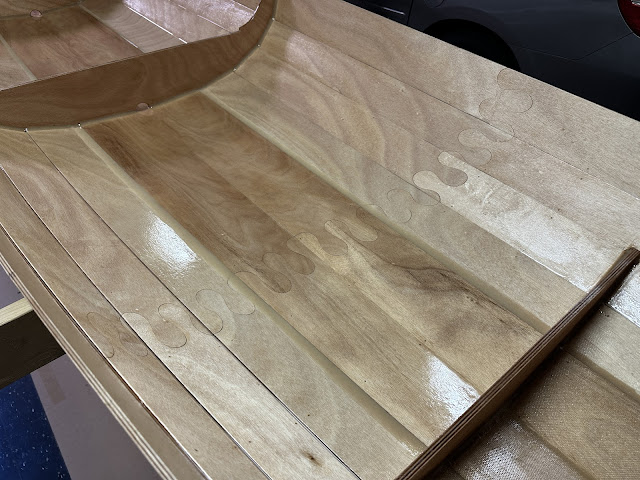Yesterday I brushed on a coat of epoxy into all the seams on the Annapolis Wherry. I then wiped the planks down to get rid of any drips but made sure to allow epoxy to settle into the seams.
Today I gently hand-sanded the seams just to rough up the epoxy so that the next coat would stick.
I then epoxy coated the entire inside of the hull. Remember that I had already sanded the fiberglass on the bottom two planks and they were ready to go.
This coat was to add a second coat to the fiberglass to start to fill the weave, and to add a first coat to the bare wood on the upper three planks on each side.
I used three tools: An epoxy spreader, and 3" roller with an Wooster Tiz epoxy roll on it, and a 2" foam brush.
The Annapolis Wherry is an easy one to epoxy coat because the boat is neatly divided into five separate sections. That way you can completely take care of one section without feeling like you have to rush to the next one.
I did one section at a time.
First I mixed up about ten pumps of epoxy and poured it into the second section back from the bow. I used a spreader to pull the epoxy up from the keel to the sides making sure that the sides got nicely coated.
Then I used a roller to even out the epoxy and to spread it to the top three planks in the bow section too. I was also able to bring a lot of epoxy up the other side.
I made sure to coat both sides of the bulkheads too.
Next I mixed up 4 or 5 additional pumps, just enough to do the what remained on the other side. Rolled that out evenly too.
Finally I used a brush to coat the fillets and to make sure the seams were even coated.
I did touch-ups with the roller and brush until satisfied.
Then moved on to the next section. It went really easily actually. Here's how it looks now.
Tomorrow I will lightly sand the entire inside just to rough it up so that the next coat of epoxy has something to latch onto, and then do another coat. That will be the third coat on the bottom planks and second coat on the top three.
Hopefully the weave will be completely covered, although I think I may have sanded to aggressively at first and I might be able to see the glass a bit through the epoxy. Oh well...
Then another sanding to prep for varnish later.
Stay tuned!



Comments
Post a Comment